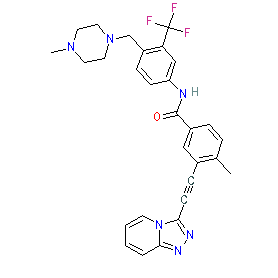|
Synonyms: compound 1 (Table 1) [WO2012173521] | PF-114 | PF114
Compound class:
Synthetic organic
Comment: Vamotinib (PF-114) is a third generation BCR-ABL kinase inhibitor [2-3]. It was designed to target wild-type resistance mutations in BCR-ABL (including the T315I gatekeeper mutation) in order to overcome drug resistance in Philadelphia chromosome positive (Ph+) leukemias. The chemical strucure is claimed in patent WO2012173521 where it is the first compound listed in Table 1 of the patent [1]. Off-targets identified by kinase profile screening include ABL2/ARG, DDR1, DDR2, FMS, FRK/PTK5, LCK, LYN, LYNB, PDGFRα and RET which had <10% residual activity when exposed to 100 nM of inhibitor [3]. We matched PF-114's chemical structure to the INN 'vamotinib' that was released in the WHO's proposed INN list 127 (21 July 2022).
Ligand Activity Visualisation ChartsThese are box plot that provide a unique visualisation, summarising all the activity data for a ligand taken from ChEMBL and GtoPdb across multiple targets and species. Click on a plot to see the median, interquartile range, low and high data points. A value of zero indicates that no data are available. A separate chart is created for each target, and where possible the algorithm tries to merge ChEMBL and GtoPdb targets by matching them on name and UniProt accession, for each available species. However, please note that inconsistency in naming of targets may lead to data for the same target being reported across multiple charts. ✖ |
|
|||||||||||||||||||||||||||||||||||
| Bioactivity Comments |
| PF-114 inhibits the ABL T315I gatekeeper mutation with an IC50 of 0.78 nM [3] (IC50 values for inhibition of a number of other ABL mutants are provided in Table 1 [3]). In a kinase profile screen PF-114 (100 nM) inhibited 11 kinases by > 90%. In contrast the ABL inhibitors ponatinib, dasatinib and nilotinib inhibited 47, 36 and 4 kinases respectively at the same concentration [3]. PF-114 inhibits growth of Ba/F3 cells expressing native and resistance mutant BCR/ABL and Ph+ patient-derived cell lines in vitro and is active in xenograft models [2]. |
| Selectivity at enzymes | ||||||||||||||||||||||||||||||||||
| Key to terms and symbols | Click column headers to sort | |||||||||||||||||||||||||||||||||
|
||||||||||||||||||||||||||||||||||







